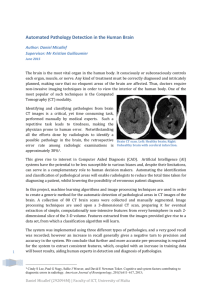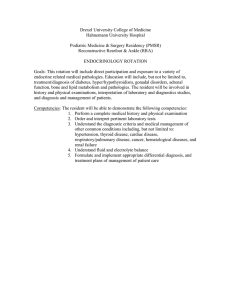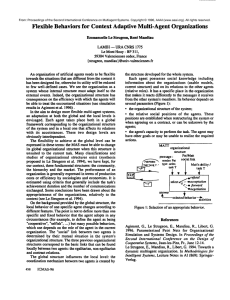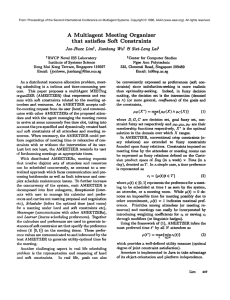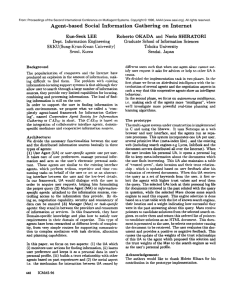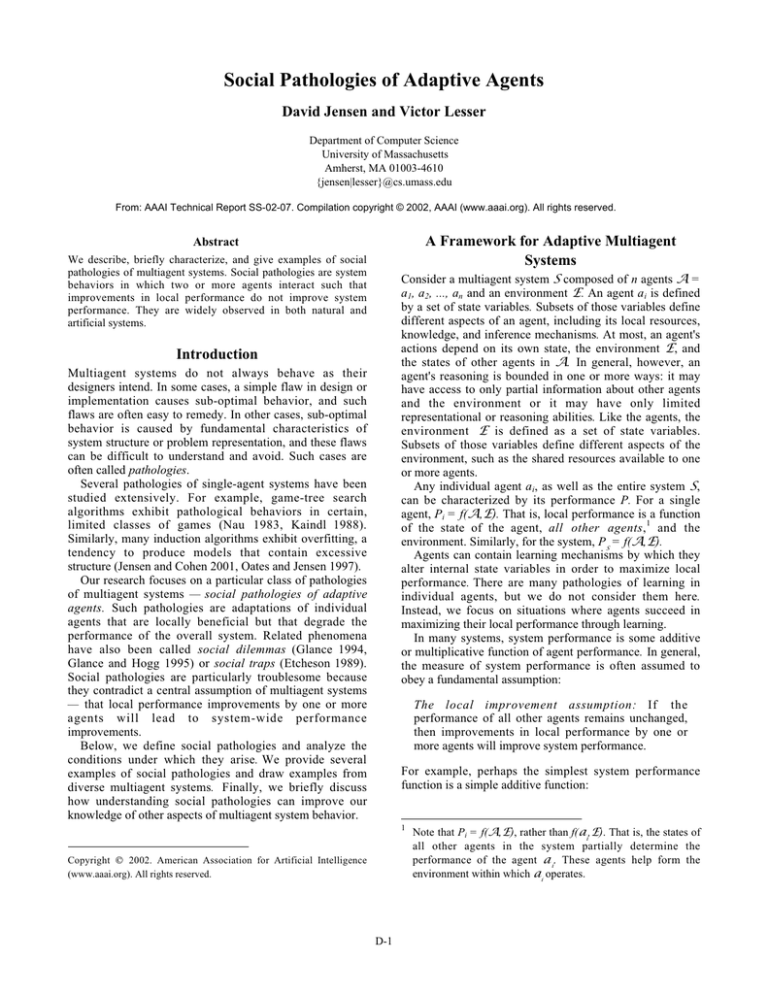
Social Pathologies of Adaptive Agents
David Jensen and Victor Lesser
Department of Computer Science
University of Massachusetts
Amherst, MA 01003-4610
{jensen|lesser}@cs.umass.edu
From: AAAI Technical Report SS-02-07. Compilation copyright © 2002, AAAI (www.aaai.org). All rights reserved.
A Framework for Adaptive Multiagent
Systems
Abstract
We describe, briefly characterize, and give examples of social
pathologies of multiagent systems. Social pathologies are system
behaviors in which two or more agents interact such that
improvements in local performance do not improve system
performance. They are widely observed in both natural and
artificial systems.
Consider a multiagent system S composed of n agents A =
a1, a2, ..., an and an environment E . An agent ai is defined
by a set of state variables. Subsets of those variables define
different aspects of an agent, including its local resources,
knowledge, and inference mechanisms. At most, an agent's
actions depend on its own state, the environment E , and
the states of other agents in A. In general, however, an
agent's reasoning is bounded in one or more ways: it may
have access to only partial information about other agents
and the environment or it may have only limited
representational or reasoning abilities. Like the agents, the
environment E is defined as a set of state variables.
Subsets of those variables define different aspects of the
environment, such as the shared resources available to one
or more agents.
Any individual agent ai, as well as the entire system S ,
can be characterized by its performance P. For a single
agent, Pi = f(A,E). That is, local performance is a function
of the state of the agent, all other agents,1 and the
environment. Similarly, for the system, PS = f(A,E).
Agents can contain learning mechanisms by which they
alter internal state variables in order to maximize local
performance. There are many pathologies of learning in
individual agents, but we do not consider them here.
Instead, we focus on situations where agents succeed in
maximizing their local performance through learning.
In many systems, system performance is some additive
or multiplicative function of agent performance. In general,
the measure of system performance is often assumed to
obey a fundamental assumption:
Introduction
Multiagent systems do not always behave as their
designers intend. In some cases, a simple flaw in design or
implementation causes sub-optimal behavior, and such
flaws are often easy to remedy. In other cases, sub-optimal
behavior is caused by fundamental characteristics of
system structure or problem representation, and these flaws
can be difficult to understand and avoid. Such cases are
often called pathologies.
Several pathologies of single-agent systems have been
studied extensively. For example, game-tree search
algorithms exhibit pathological behaviors in certain,
limited classes of games (Nau 1983, Kaindl 1988).
Similarly, many induction algorithms exhibit overfitting, a
tendency to produce models that contain excessive
structure (Jensen and Cohen 2001, Oates and Jensen 1997).
Our research focuses on a particular class of pathologies
of multiagent systems — social pathologies of adaptive
agents. Such pathologies are adaptations of individual
agents that are locally beneficial but that degrade the
performance of the overall system. Related phenomena
have also been called social dilemmas (Glance 1994,
Glance and Hogg 1995) or social traps (Etcheson 1989).
Social pathologies are particularly troublesome because
they contradict a central assumption of multiagent systems
— that local performance improvements by one or more
agents will lead to system-wide performance
improvements.
Below, we define social pathologies and analyze the
conditions under which they arise. We provide several
examples of social pathologies and draw examples from
diverse multiagent systems. Finally, we briefly discuss
how understanding social pathologies can improve our
knowledge of other aspects of multiagent system behavior.
The local improvement assumption: If the
performance of all other agents remains unchanged,
then improvements in local performance by one or
more agents will improve system performance.
For example, perhaps the simplest system performance
function is a simple additive function:
1
Copyright 2002. American Association for Artificial Intelligence
(www.aaai.org). All rights reserved.
D-1
Note that Pi = f(A,E), rather than f(ai,E). That is, the states of
all other agents in the system partially determine the
performance of the agent a i. These agents help form the
environment within which ai operates.
Ps = ∑ Pi
agent improves its own performance by adversely affecting
the environment for other agents. This is the basis of the
Tragedy of the Commons (TOC).
In TOC, an agent improves its own performance by
making greater use of one part of the environment —
typically a shared resource. The shared resource responds
to the increased demand by more than proportionately
decreasing the value it provides to all other agents.
Typically, this behavior results from the lack of excess
capacity in the resource, and transaction costs associated
with increased use.
Consider the hypothetical example of a processor shared
by ten agents. The processor has a capacity of 100 units
(measured on some consistent scale of computational
resources), with 2 units/agent devoted to the costs of
context switching among the different processes. As a
result, 80 units are spent on useful computation. Because
each agent requires 8 units, the processor is used at
precisely its current capacity. If an eleventh agent begins
using the processor, a total of 100-(11*2) or 78 units will
be spent on useful computation. Because the processor is
being used at capacity and transaction costs exist, an
additional agent reduces the total useful computation the
processor can perform (despite a local improvement in the
new agent's performance due to its use of the processor).
TOC is probably the best-know pathology of multiagent
systems. It is most commonly understood in the context of
natural resource systems. For example, Hardin's classic
paper (Hardin 1968) uses the example of a common
grazing land for cattle that is shared by several herdsmen.
Each herdsman makes choices about how many cattle to
graze on the common land. In such cases, the common land
is almost always overused, resulting in lowered overall
yields. Another example of TOC has been labeled “the
diner's dilemma” (Glance 1994). Each of several dining
companions orders a meal from the menu and then the bill
is split evenly among all parties. An extravagant diner
receives all the benefits of ordering an expensive meal, but
bears only a small portion of the costs. In such cases,
individuals are well served by ordering an expensive meal,
yet the costs skyrocket if all diners follow this policy.
Analogous situations are common in computational
multiagent systems. Systems can have many shared
resources, such as processors, memory, long-term storage,
external sensors, and communications channels. For
example, Sugawara and Lesser (1994) describe a shared
communication channel that quickly becomes overloaded
because of the uncoordinated actions of several agents.
Turner (1993) provides a number of other examples.
Counterexamples also exist. One can easily imagine the
inverse of TOC — what might be called the “blessing of
the commons” — a situation in which an agent's actions
improve both local and system performance. For example,
blackboard systems demonstrate this behavior. The data
collection and reasoning efforts of a single agent are posted
to a central repository, potentially increasing the
performance of all other agents.
i
Designing effective multiagent systems is largely about
upholding the local improvement assumption. In welldesigned systems, changes in information and
decisionmaking that improves the performance of a single
agent also improves the performance of the entire system.
There is often no guarantee that system performance will
reach a global maximum, but many multiagent systems are
based on the assumption that local performance
improvements will, at a minimum, improve system-wide
performance.
Clearly, there are many relatively simple violations of
the local improvement assumption. For example, agents
can have characteristics that interfere with the local
improvement assumption either unintentionally (e.g., a
poorly-designed measure of local performance) or
intentionally (e.g., computer viruses).
This paper deals with social pathologies — more
complex behaviors that violate the local improvement
assumption.
Social pathology: a system behavior in which two or
more agents interact such that improvements in local
performance do not improve system performance.
Social pathologies are emergent properties of mulitagent
systems — system behaviors that cannot be examined at
the agent level, but can only be examined at the system
level.
Types of Social Pathologies
How do social pathologies arise? Under what conditions
can interactions change an agent's state, improve its local
performance, but degrade system performance? Recall that
Pi=f(A,E) and PS=f(A,E). For simultaneous improvement
in one or more agent's performance and degradation in
system performance, either the agents A or the
environment E must change. If we assume the
environment is free from external fluctuations, then either
the agents themselves must change or they must change
environment.
In the remainder of this section, we discuss four
pathologies in terms of how a agent interactions can
adversely affect system performance. First, we discuss a
pathology where a change by one agent affects the
environment E of all agents (tragedy of the commons).
Next, we discuss a pathology where a change by one agent
affects the aggregate characteristics of all agents A (lockin). Finally, we discuss two pathologies where a change by
one agent affects the behavior of one or more other agents
(cycling and blocking).
Tragedy of the Commons
The environment E is one determinant of both agent and
system performance. A social pathology will result if an
D-2
One common solution to TOC is to communicate the
true cost of using shared resources via a system of prices.
Wellman (1993) explores the use of an artificial economy
to derive the activities and resource allocations for a set of
computation agents. This approach has also been employed
in human societies when shared resources have been
overexploited. Pollution taxes, license fees, and auctions of
public goods have all been employed to allocate resources
that are both scarce and shared to their most useful purpose
and communicate the true cost of resources to the agents
that use them.
the initial state. Cycling occurs in systems where one
agent's state affects the relative performance of other
agents' states. An initial state change by one agent
increases the desirability of a state change by another
agent. Cycling consumes computational resources without
producing any corresponding benefit.
Arms races are a frequently-studied form of cycling in
international politics (Etcheson 1989, Gleditsch and
Njolstad 1990). Nations often measure the performance of
their national defense policy in terms of their security with
respect to a potential aggressor. Thus, security depends not
only on a nation's environment (e.g., its geographic
position) but also the state A of other agents in the system.
When one nation changes the state of its military forces
(e.g., by developing a new weapons system), other nations
may perceive their security to be reduced, and change state
as well (by developing a similar or countervailing weapons
system). This, in turn, changes the security of the first
nation. Such arms races can proceed for years or decades,
with both nations consuming large amounts of resources
but attaining no greater security.
Similarly, arms races have been observed in biological
systems on evolutionary time scales (Dawkins 1986,
Dawkins and Krebs 1979, Van Valen 1973). The
performance of predators depends on their prey and vice
versa. This can lead to a string of evolutionary adaptations
in predators (e.g., faster running speed, sharper teeth,
keener eyesight) and in prey (e.g., faster running speed,
harder shells, and better camouflage, respectively). While
these changes in individual species could be termed
“improvements,” they often produce no net change in the
relative advantage among predators and prey.
Cycling is related to, but distinct from, two well-known
computational phenomena. Early networks sometimes
reached a state where messages endlessly cycled among a
finite set of routers, never reaching their final destination.
This phenomenon, sometimes called “ping-ponging,”
produces a cycle, but not a cycle with respect to agent
state; the messages cycle, not the routers' behavior.
Another phenomenon similar to cycling, often called
“thrashing,” occurs in time-sharing systems that
accomplish little useful computation because the system
spends nearly all it cycles shifting among multiple
processes. Thrashing captures the aspect of looping
behavior and poor performance, but the looping is an
intentional part of a time-sharing system and the behavior
associated with each process does not change.
Lock-in
Some system properties that determine performance may
not be derivable from individual agents. One example of
such a system property is agent diversity. Diversity can be
an important determinant of long-term system performance
by increasing a system’s ability to adapt to sudden
environmental changes or external attack. For example,
biodiversity is widely regarded by biologists as a necessary
condition for ecosystem health. Similarly, recent work in
computer science has examined the importance of diversity
in operating systems and security measures to combat
viruses and direct attack. However, some systems reward
individual agents for conforming to a prevailing standard,
reducing diversity and degrading system performance. This
is the essence of lock-in.
Lock-in occurs when individual agents can improve their
performance by conforming to some aspects of another
agent's state. One agent may adopt another agent's beliefs
or reasoning techniques. Sociologists refer to the incentive
to conform as “social pressure” and to the outcome as
“groupthink.” Economists sometimes call the pressure to
conform a “network externality” and sometimes refer to
the outcome as a “monopoly.”
In addition, small perturbations in the initial states of
agents can lead to selecting suboptimal beliefs and
reasoning techniques. If the local performance associated
with a set of beliefs depends partially on the extent to
which they are shared by other agents, then the initial state
of all agents can determine which belief system prevails.
This can lead to a suboptimal state if initial conditions
favor a belief system that, when adopted by all agents, has
lower performance than another. This sort of lock-in has
been recently identified in economic systems (Arthur
1990).
Cycling
Blocking
Changing state can require significant computational
resources from an agent, disrupt previously stable agent
behaviors, and require other agents to change state as well.
This can degrade system performance until a new
equilibrium is reached. Cycling is a pathology where no
new equilibrium is reached.
In cycling, a system's agents engage in a series of
ultimately circular state transitions. This can proceed
indefinitely, or end in a state with the same performance as
Environments can impose limitations on agent states and
their relative performance. For example, only a fixed
number of agents may be able to fulfill a particular role in
a system, or the performance associated with a particular
agents state may depend on the states of other agents in the
system. This characteristic of environments and agents can
lead to blocking.
In blocking, one or more agents occupy a particular role
in a system. Because they occupy that role, other agents
D-3
cannot, even though system performance would improve
under a different arrangement of agents and roles. Blocking
occurs because of how the environment structures
performance, and because of the current states of agents.
Given other states, or a more flexible environment, system
performance would improve.
For example, biological systems can exhibit blocking
due to the presence of ecological niches. In the short term,
a species may not be able to extend its geographic range
into a new region because its particular niche is filled by
another species in that region. In the long term, a particular
evolutionary path may be prevented because another
species fills the niche into which another species might
move. In human societies, blocking can occur in terms of
positions within an organization (two employees often
cannot fill the same position) and in terms of marital
pairings (bigamy is outlawed). A computational model that
exhibits blocking has been created by Numaoka (1995).
and Air Force Research Laboratory or the U.S.
Government.
References
Arthur, B. 1990. Positive Feedbacks in the Economy,
Scientific American. February.
Cross, J. and Guyer, M. 1980. Social Traps. Ann Arbor:
University of Michigan Press.
Dawkins, R. 1986. The Blind Watchmaker. New York:
W.W. Norton.
Dawkins, R. and Krebs, J. 1979. Arms races between and
within species. Proceedings of the Royal Society of
London B 205:489-511.
Etcheson, C. 1989. Arms race theory: Strategy and
structure of behavior. New York: Greenwood.
Gleditsch, N. and Njolstad, O. eds. 1990. Arms races:
Technological and political dynamics. London:
Sage Publications.
Discussion
We have described only a few of a potentially large
number of social pathologies associated with multiagent
systems. The examples of tragedy of the commons, lock-in,
cycling, and blocking illustrate the ways in which the local
improvement assumption can be false. They highlight this
assumption as an important property of multiagent
systems. Systems which guarantee the validity of the local
improvement assumption are “safe” — they cannot exhibit
pathological behaviors.
Unfortunately, it is not clear how the local improvement
assumption can be guaranteed without sacrificing the
promise of multi-agent systems. For example, one obvious
way of guaranteeing that local improvement leads to global
improvement is for the actions of each agent to be
independent. That is, the actions of each agent cannot
affect the performance of other agents. However, this also
removes the possibility of beneficial interactions among
agents, the sine qua non of multiagent systems.
Instead, designers of multiagent systems should be alert
to the possibility of social pathologies in adaptive agents,
and researchers should continue to identify, investigate,
and catalog them. We hope this paper provides a first step
in this direction.
Glance, N. and Huberman, B. 1994. The dynamics of
social dilemmas. Scientific American. March. 7681.
Glance, N. and Hogg, T. 1995. Dilemmas in computational
societies. In Proceedings of the First International
Conference on Multi-Agent Systems (ICMAS-95).
Menlo Park, California: AAAI Press. 117-124.
Hardin, G. 1968. The tragedy of the commons. Science
162:1243-1248.
Jensen, D. and Cohen, P.R. 2001. Multiple comparisons in
induction algorithms. Machine Learning 38(3):309338..
Kaindl, H. 1988. Minimaxing: Theory and practice. AI
Magazine 9(3): 69-76.
Nau, D. 1983. Pathology on game trees revisited, and an
alternative to minimaxing. Artificial Intelligence
21:221-244.
Numaoka, C. 1995. Introducing the blind hunger dilemma:
Agents' properties and performance. In Proceedings
of the First International Conference on MultiAgent Systems (ICMAS-95). Menlo Park,
California: AAAI Press. 290-296.
Acknowledgments
This research is supported by The Defense Advanced
Research Projects Agency (DARPA) and Air Force
Research Laboratoy, Air Force Material Command, USAF,
under agreement number F30602-00-2-0597. The U.S.
Government is authorized to reproduce and distribute
reprints for governmental purposes notwithstanding any
copyright notation hereon. The views and conclusions
contained herein are those of the authors and should not be
interpreted as necessarily representing the official policies
or endorsements either expressed or implied, of the The
Defense Advanced Research Projects Agency (DARPA)
Oates, T. and Jensen, D. 1997. The effects of training set
size on tree size. Proceedings of the Fourteenth
International Conference on Machine Learning.
254-262.
Sugawara, T. and Lesser, V. 1998. Learning to improve
coordinated actions in cooperative distributed
problem-solving environments. Machine Learning
33:129-153.
D-4
Turner, R. 1993. The tragedy of the commons and
distributed AI systems. In Twelfth International
Workshop on Distributed Artificial Intelligence,
Hidden Valley, PA, 1993. 379-390.
Van Valen, L. 1973. A new evolutionary law. Evolutionary
Theory 1:1-30.
Wellman, M. 1993. A market-oriented programming
environment and its application to distributed
multicommodity flow problems. Journal of AI
Research 1:1-23.
D-5

